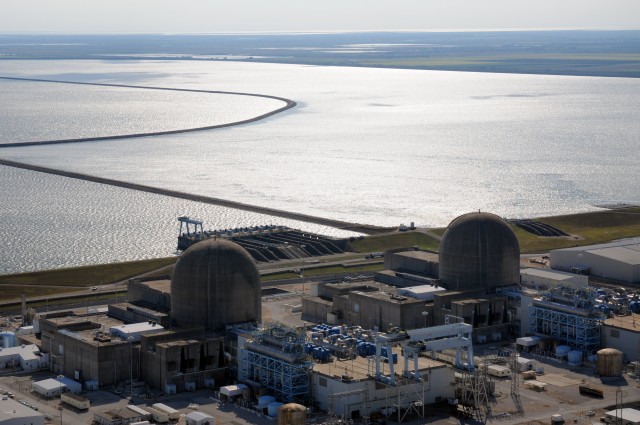Timely Rains Replenish Nuclear Cooling Reservoir

The reservoir that cools the South Texas Project’s two nuclear reactors has been low in 2013 and 2011 because of drought conditions. Photo courtesy of the South Texas Project.
By Dylan Baddour
For Reporting Texas
In 25 years of operation, a nuclear plant in Matagorda County has never had to ask for backup water to cool its reactors, but recently it’s gotten closer than ever.
Were it not for a timely assist from Mother Nature, the South Texas Project, which supplies energy to 2 million Texas homes in Austin, Dallas, and San Antonio, might have needed the additional water this year. The plant uses water from the Colorado River to cool its two nuclear reactors. When its 7,000-acre cooling reservoir falls below 37 feet, the plant must warn the local river authority that it may need more water.
According to the Lower Colorado River Authority spokesperson Clara Tuma, the plant sent that notification in September, and the LCRA began reviewing options for how and when to deliver backup water. Heavy rains in October made it the year’s wettest month so far, solving the problem for now, but the notification highlights a trend of dwindling Central Texas water supply. The plant has issued only one such notification before, in the fall of 2011.
The LCRA limits how much water different entities can take from the river. The City of Austin gets the most — 138,560 acre-feet. An acre-foot is about 326,000 gallons, enough to fill 16 to 20 backyard pools. The nuclear plant is next in at 102,000 acre-feet. But the plant is limited more by the river itself than by the river authority. Usually the plant takes about 40,000 acre-feet of water from the river, but this year flows have been so low that the plant could take only 4,700 acre-feet.
If the Colorado River cannot meet the cooling needs of the two nuclear reactors, the South Texas Project is entitled to 20,000 acre-feet of backup water which the LCRA must supply from any source available. This includes water in the strained Highland Lakes reservoirs that supply water to Austin and most of Central Texas.
“The goal would be to deliver the water in a way that would minimize the amount of stored water from the Highland Lakes,” Tuma said.
STP spokesman Buddy Eller said that the September message was only a “required procedural notification” under the long-term water contract between the power plant and the river authority. According to the contract, the LCRA must be alerted once the reservoir level hits 37 feet, and backup water must be delivered if the level falls to 35 feet. October rains had brought the level to 39.3 feet as of Nov. 4.
Eller said the October rains replenished the lower Colorado River basin, and for now reservoir levels seem safely above the critical mark.
“We haven’t seen these types of river flows since early 2012,” Eller said. “We’ve got a real good push.”
But, Tuma said, the power plant will not have much time to pump large flows from the Colorado River before they pass downstream into the gulf. Another dry summer could threaten the area’s water supply again.
State climatologist John Nielsen-Gammon said it is impossible to predict long-term trends in rainfall. But using historical data of inflows to the Highland Lake reservoirs since 2002, when Texas officially entered the current period of long-term drought susceptibility, he said the odds are about even that the lakes will refill substantially over the next eight to 12 months.
For regions southeast of Austin that don’t rely heavily on the Highland Lakes, recent rainfall provided some hope.
“The rain has produced a substantial improvement to drought conditions along and east of I-35,” Nielsen-Gammon said. “We may well see most of the eastern half of Texas moving toward drought-free conditions.”